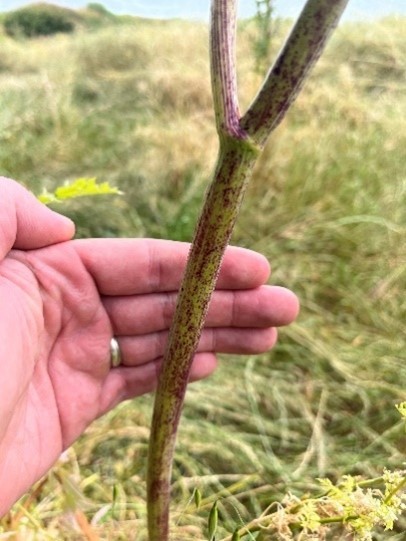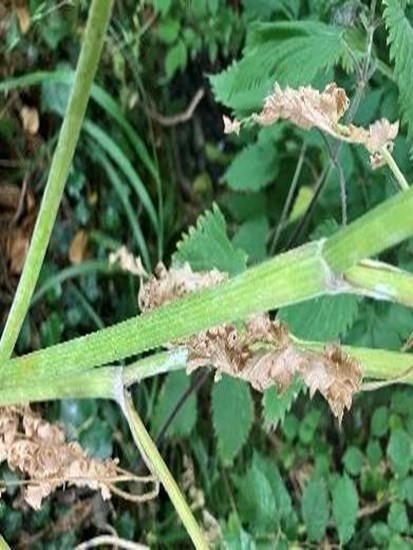- Home
- Risks of hemlock weed in livestock farms
Risks of hemlock weed in livestock farms
Hemlock is a significant risk to livestock due to its highly toxic nature. Learn how to identify and control it.
Hemlock looks like many other umbellifer weeds (like cow parsley), but it has a smooth stem with purple spotting.

Hemlock stem

Cow parsley stem

Hemlock in hay (before bailing)
Key risks
All parts of the plant contain toxic alkaloids, which can be fatal if ingested. Even small amounts can cause severe poisoning.
Signs of poisoning in livestock
- Nervousness
- Trembling
- Muscle weakness
- Respiratory distress
- Drooling
- Dilated pupils
- Paralysis
Death can occur within hours of ingestion due to respiratory failure.
Hemlock can rapidly spread in pastures and fields and along waterways, making it difficult to control once established. It thrives in moist, disturbed soils.
If hemlock contaminates hay or silage, it remains toxic and can pose a risk even when livestock are not grazing directly on the plant.
Management of hemlock weed in livestock farms
Effective management of hemlock weed involves a combination of:
- Prevention
- Mechanical control
- Chemical control
- Ongoing monitoring
Prevention
- Maintain healthy, dense pastures to outcompete hemlock and other weeds
- Monitor ditches and field margins for signs of hemlock and remove them before seed formation
Mechanical control
- Small infestations can be controlled by manually removing plants, including roots, to prevent regrowth. Protective clothing should be worn to avoid skin contact
- Regular mowing can prevent hemlock from flowering and setting seed, but it may need to be combined with other methods for effective control. Mown hemlock is still poisonous and becomes more palatable once wilted. Cattle should not graze until it has been completely removed
Chemical control
Selective herbicides can be effective, particularly those containing 2,4-D or glyphosate.
Herbicide application should be timed for early spring when plants are young and actively growing.
Applications made after flowering has begun will be less effective and target plants in the rosette stage.
Dead or wilting plants remain poisonous and may become more palatable, so ensure cattle do not graze until the weed has been removed or has completely disappeared.
Multiple applications may be necessary to control regrowth and seedlings.
Ongoing monitoring
- Regularly inspect pastures, fence lines and watercourses for new infestations
- Maintain records of infestations and control measures to track progress and plan future actions
Safe disposal
Removed plants should be disposed of safely to prevent seeds from spreading.
This can include burning or bagging and disposing the plants in a landfill.
Emergency response
- Have a plan for rapid veterinary response in case of suspected poisoning; immediate treatment can sometimes save affected animals
- Quickly remove livestock from areas where hemlock is found to prevent ingestion

